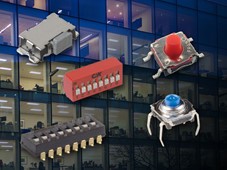By Mike Bolduc | November 20, 2017

If you work in an environment that’s “harsh,” then you know the importance of making sure your equipment can withstand regular and repeated usage, continued exposure to the elements, or can still operate even when in contact with many foreign elements. What would be considered by the industry to be “harsh,” you ask? Think of hospitals or medical facilities, manufacturing facilities, power plants or anything that’s located outdoors.
When people think of equipment for these types of harsh environments, most think of heavy machinery or life-saving devices. One commonality between these environments, however, is that they all need lighting for employees to be able to do their jobs – and the proper controls for them to be able to access and adjust said lighting.
While there are many types of switches used in lighting applications – common products include tact switches, toggle, DIP, pushbutton and rotary switches – any designed into products for use in harsh environments must be stronger and able to withstand more damage than their counterparts designed for residential use. But to design for this category effectively, engineers and product designers need to keep the following five requirements top of mind:
- Haptic Feedback: Having poor or low haptic response from your tact switch may lead users to feel that the product isn’t working, or was of low quality to begin with. Fine tuning or customizing the haptics to the environment that the switch will be used in will help ensure a great customer experience
- Cycle Life: Harsh environments demand long lifecycles. A DIP switch in a wireless motion sensor or wall switch module may only be used a few hundred times, but may be in an environment which can cause oxidation or corrosion of the contacts. On the other hand, wall switches, timers, dimmers and shade controls may be used dozens of times per day and may need to last for hundreds of thousands of cycles.
- Mechanical Layout: How much space is on the circuit board? How many switches will be included in the product? How will the user interact with the switch? What are the forces which will be placed on the switch? What are the tolerances in the product design which need to be accommodated by the switch? These questions help determine the required footprint and overall height of the switch, the actuator height and amount of travel required, or whether a thru-hole type (THT) device is required over a surface mount (SMT) for added strength.
- Sealing and Protection: Better protection equals improved performance and reliability, as well as longer cycle life. Where will the lighting application be used? Indoors or outdoors? What is the potential temperature range? Will the switch be used in a clean environment? A rugged workplace like a factory floor? Will the light be subjected to moisture, dust, salt air, or corrosive environments? Without the proper plating and contact system design, contact oxidation and corrosion can be a problem, especially if low level currents are used in the product.
- Durability: Performing maintenance or repair on lighting products can be difficult and time consuming given the location and accessibility of many of these devices. Designing products which are maintenance-free or that perform reliably for many years is of significant benefit to the end user. Materials, contact system design, over-travel and over-force protection are all key considerations to have in mind when determining the ability of the switch to hold up to repeated use in harsh environments and usage conditions.
When designing for a harsh environment, switches and every component used need to be protected from the elements and overuse. However, if you make sure these requirements are incorporated in your design process, then you can be ready for anything a harsh environment could throw at you.

Mike Bolduc
Global Segment Manager
Industrial
